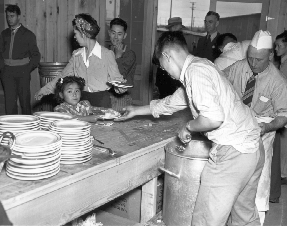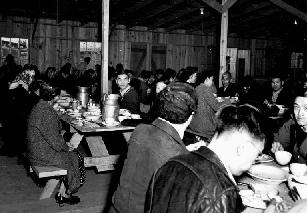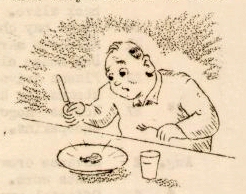|
Seattle Post-Intelligencer Collection. Museum of History and Industry, Seattle, Washington.
|
Photograph used in the PI, May 25, 1942 with the caption, "Soup's on -- Japanese evacuees from Seattle lining up for mess alongside what once served as an exhibit building at the Western Washington Fair grounds, Puyallup."

|
|
Japanese Evacuation Report #11. Written by Joseph Conard of the Seattle Office of the American Friends Service Committee dated May 11, 1942. Joseph Conard, Collector, Box 4, Hoover Institution Archives.
|
There's not enough milk for the babies in camp because the Army's contract for milk is with farmers in Oregon and even though there is plenty of milk in the neighboring towns begging to be used, red tape makes it impossible. There hasn't been enough food to go around because there were mare [sic] arrivals than were expected. Some have gone without meals several times. There has been no fresh vegetables; no fruit (and a large part of the population are children), no fresh meat, but plenty of canned food for those who were early in line to get it. (long lines outside each mess hall: long lines for almost everything is the order of the day out here).
|
|
Nakashima, Ted, "Concentration Camps: U.S. Style." New Republic, Volume 106, June 15, 1942, pg. 822.
|
The food and sanitation problems are the worst. We have had absolutely no fresh meat, vegetables or butter since we came here. Mealtime queues extend for blocks; standing in a rainswept line, feet in the mud, waiting for the scant portions of canned wieners and boiled potatoes, hash for breakfast or canned wieners and beans for dinner. Milk only for the kids. Coffee or tea dosed with saltpeter and stale bread are the adults' staples.
|
|
Excerpts from Letters from Japanese Evacuees in Assembly and Reception Centers. Compiled on May 25, 1942. Joseph Conard, Collector, Box 4, Hoover Institution Archives.
|
There has been a scarcity of bread the last few days, in addition to the scarcity of milk, butter and eggs. I don't know nor do any of the chefs know just what is holding up the mess supplies. May of the fellows who are doing heavy work, like hauling the baggage of new arrivals, eat the same meal in two separate mess halls in order to get enough. Many of the cooks are getting disgusted. Complaints against unbalanced (and sometimes insufficient) meals come to them, and it isn't their fault at all.
|
|
Seattle Post-Intelligencer Collection. Museum of History and Industry, Seattle, Washington.
|

|
|
Life in Camp Harmony. In Nisei Daughter, Seattle: University of Washington Press.
|
Lunch consisted of two canned sausages, one lob of boiled potato, and a slab of bread. Our family had to split up, for the hall was too crowded for us to sit together. I wandered up and down the aisles, back and forth along the crowded tables and benches, looking for a few inches to squeeze into.
|
|
Visit to Puyallup Assembly Center. Report by Mary I. Barber, and Lieutenant J.W. Brearly dated July 21, 1942. In American concentration camps: a documentary history of the relocation and incarceration of Japanese Americans, 1942-1945. New York: Garland, 1989.
|
The food is excellent in quality and the cooking was good. Unusual care was taken by the girls who served to see that the plates were made attractive. The service was slow in this mess, due to a bottle-neck in the feeding line. It was suggested that two lines could be set up. There was ample space for additional people and there seemed to be no reason why they could not all sit down at the same time. A second line would prevent hundreds of people from standing around waiting for the first group to finish feeding.
The pastry products are made daily in the bake shop of this area and distributed to the entire camp. This was the only place on our tour that we saw this procedure being carried out. The products were delicious and the cooks used recipes, so that there was some standardization in their methods and the results.
|
|
Report of the American Red Cross Survey of Assembly Centers in California, Oregon, and Washington. In Papers of the U.S. Commission on Wartime Relocation and Internment of Civilians. Part 1, Numerical file archive. Reel 10.
|
Japanese food habits can be considered only to a limited extent in planning menus because certain food items needed for Japanese dishes are difficult to secure. But a small supply of Japanese foods such as white miso sauce, dried shrimp, kombu, and soy sauce which were found in some warehouses in the centers are being used. Many of the centers are pickling vegetables and serving them on the menu. A check of menus shows some foods which are particularly liked by the Japanese, such as rice, rice cakes, fresh fish, pickled vegetables, miso soup, soy sauce, sukiyaki, shrimp sushi, and chop suey. In some of the centers these foods are served frequently, in others only occasionally. Rice is usually served once or more a day.
The approximated daily cost of the ration in each of the centers is as follows:
Tulare $ .447 Tanforan $ .31 - .34
Fresno .389 Pomona .44 - .46
Merced .444 Santa Anita .38
Stockton .4113 Puyallup .481
The Army allowance is fifty cents per person per day.
|
|
Photograph by Tacoma News Tribune photographer, Howard Clifford. UW6913. UW Libraries Special Collections.
|

|
|
Camp Harmony Newsletter, July 18, 1942.
|
RICE RETURNS TO HARMONY DIET
Center enthusiasm over gastronomic improvements resulting from the recently instituted Army rations were expected to rise to delirious heights, as Housing and Feeding Supervisor Clyde C. Randall announced the arrival of quantities of rice.
The center staple had been missing from the mess tables for a few days following the change to Army rations, but was to be available again with last Friday's fish dinner.
|
|
Camp Harmony Newsletter, Souvenir edition, August 1942.
|
At first the food was bad, then they got off the canned rations and the meals were better. Pretty soon we were getting cantaloupes once in a while and raspberries three times a day while they were paying a dollar a crate for folks to pick them. Then one memorable day there was steak for lunch and three pork chops a piece for supper, and then they started to kick about too much meat on the menu.

|



